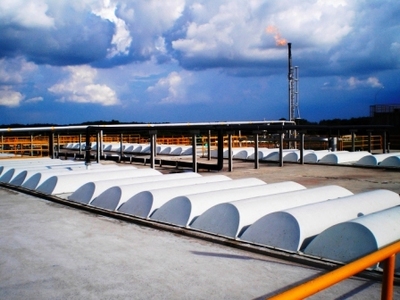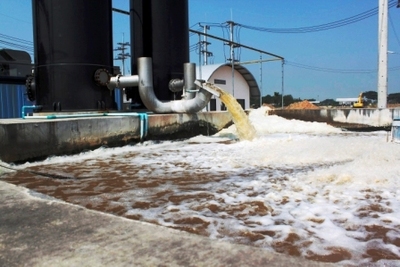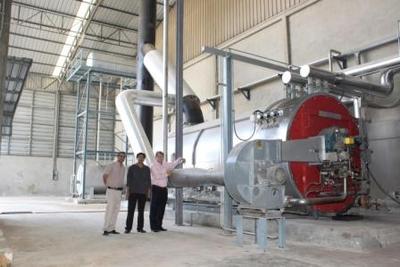Green power from wastewater with anaerobic technologies
Monday, 25 June, 2012
Green energy generation from industrial wastewater does not always get as much attention as more traditional renewables such as solar and wind. In fact, there lies a huge, often hidden potential in using industrial wastewater as a source of renewable energy. Mr Jean Pierre Ombregt* encourages businesses with organic content in their wastewater and waste streams to investigate the anaerobic potential for their specific case.
The concept of using wastewater to create green energy is much more widely applicable than often realised. Any factory with a biological waste stream or wastewater with high COD (chemical oxygen demand) can easily use this model to generate energy. Some companies making the investment have achieved payback within a year. Most typically achieve it within two years.
But most industries have not realised the potential of this green energy cash cow. They have mainly been focusing on treating their effluent to meet local discharge standards at the lowest possible investment costs. By doing so, wastewater treatment installations have only generated additional operating costs and have never been seen as revenue generators.
However, applying anaerobic wastewater treatment sheds a whole different light on the cost structure of wastewater treatment infrastructure. It can now actually become a substantial additional source of income for many factories and processing plants throughout the world, including the food, beverage and agro industry and other primary product processing plants throughout the world - including, particularly, the expanding primary production businesses of vigorously growing areas such as Asia-Pacific, Eastern Europe and South America.
Power from effluent

In realising the value by anaerobically treating organic effluent and waste material, a whole series of benefits come into play.
The first benefit is of course the clean effluent, efficiently dealing with an important waste stream many companies have to contend with. On average the removal efficiency of GWE’s anaerobic wastewater treatment installations is as high as 90-95%, bringing the organic load down to regulatory discharge standards for some types of wastewater. For more heavily loaded wastewaters, relatively small extra post-treatment steps can further purify the effluent, meeting even the most stringent discharge regulations for water re-use.
Besides cleaning the wastewater (which other processes can ultimately achieve), by far the greatest advantage of anaerobic wastewater treatment is the controlled, continuous production of valuable biogas that occurs during the wastewater treatment. Other types of treatment, such as aerobic and physicochemical processes, do not provide this benefit.
Closed anaerobic reactors generate large quantities of methane (CH4) from the organic materials in the wastewater that can diminish or even completely replace the use of fossil fuels in the production process. To bring some perspective to the value, one tonne of COD digested anaerobically generates 350 Nm3 of methane, equivalent to approximately 312 L of fuel oil, or generates about 1300 kWh of green electricity.
For specific industry applications with high organic loads, enough biogas can be generated to fully cover a factory’s fossil fuel needs and still have a biogas surplus to feed into power generators to produce electricity for the owner’s use or for sale to the national grid.
A project recently completed for a 300 tonne/day tapioca starch factory in Thailand illustrates this. The fossil fuel equivalent of the biogas generated in the anaerobic digestion of the starch factory’s wastewater is approximately double what is required for the mill’s production, making the factory 100% self-sufficient for its fossil fuel needs. The surplus biogas is used to generate green electricity, which is sold back to the grid, generating additional revenues.
For a greener footprint
But it doesn’t end there. The GWE closed anaerobic process systems prevent large quantities of CH4 being emitted into the atmosphere. With CH4 being 21 times more harmful than CO2, GWE’s anaerobic wastewater solutions can also qualify for Emission Reduction Certificates for projects in countries listed under the United Nations Kyoto Clean Development Mechanism (CDM) and Joint Implementation (JI) programs.

Besides the economical advantage of GWE’s anaerobic wastewater treatment, there is clearly also the environmental advantage, significantly reducing factories’ carbon footprints. Not only by supplying renewable energy and thus reducing or even eliminating the use of fossil fuels, but also by replacing more traditional, CH4-polluting, open lagoons and by replacing power consuming and waste sludge producing traditional aerobic WWTPs.
Can I also apply it to my factory?
Anaerobic wastewater treatment with biogas recovery is possible for a very wide range of industries. The main criteria for energy-generating projects to become viable is the COD content of the effluents. The higher the organic load of the wastewater, the more biogas and thus renewable energy can be generated from it. Cost of fuel also plays a significant role. As the world is learning to live with higher petroleum prices, currently peaking well over US$100 a barrel, choosing anaerobic technology now holds the key to immediate and future safeguarding of power supply for many industries.

Typical industries that are suitable for anaerobic wastewater treatment are:
- beer and beverages (beer, soft drinks, tea, coffee- and milk-based drinks, fruit juices)
- food processing and canning (fruits, vegetables, meat, fish, seafood)
- snacks, confectionery, dairy industry
- fermentation industry (alcohol, yeast, monosodium glutamate)
- biofuels (ethanol, biodiesel)
- pulp and paper
- agro and agroprocessing industries (vegetables, beet sugar, starch, palm oil)
- petrochemical (PTA, PET, glycol and polyester factories)

Researchers trial magnetic resin to remove PFAS
A magnetic resin invented at The University of Queensland will be trialled at wastewater...
A sustainable approach to increase wastewater recycling
Flinders University research is investigating improved effluent treatment and biosolids removal...
Inverell upgrades 30-year-old aeration system
The project entailed building a new tank at the Inverell Sewage Treatment Plant, to allow...







